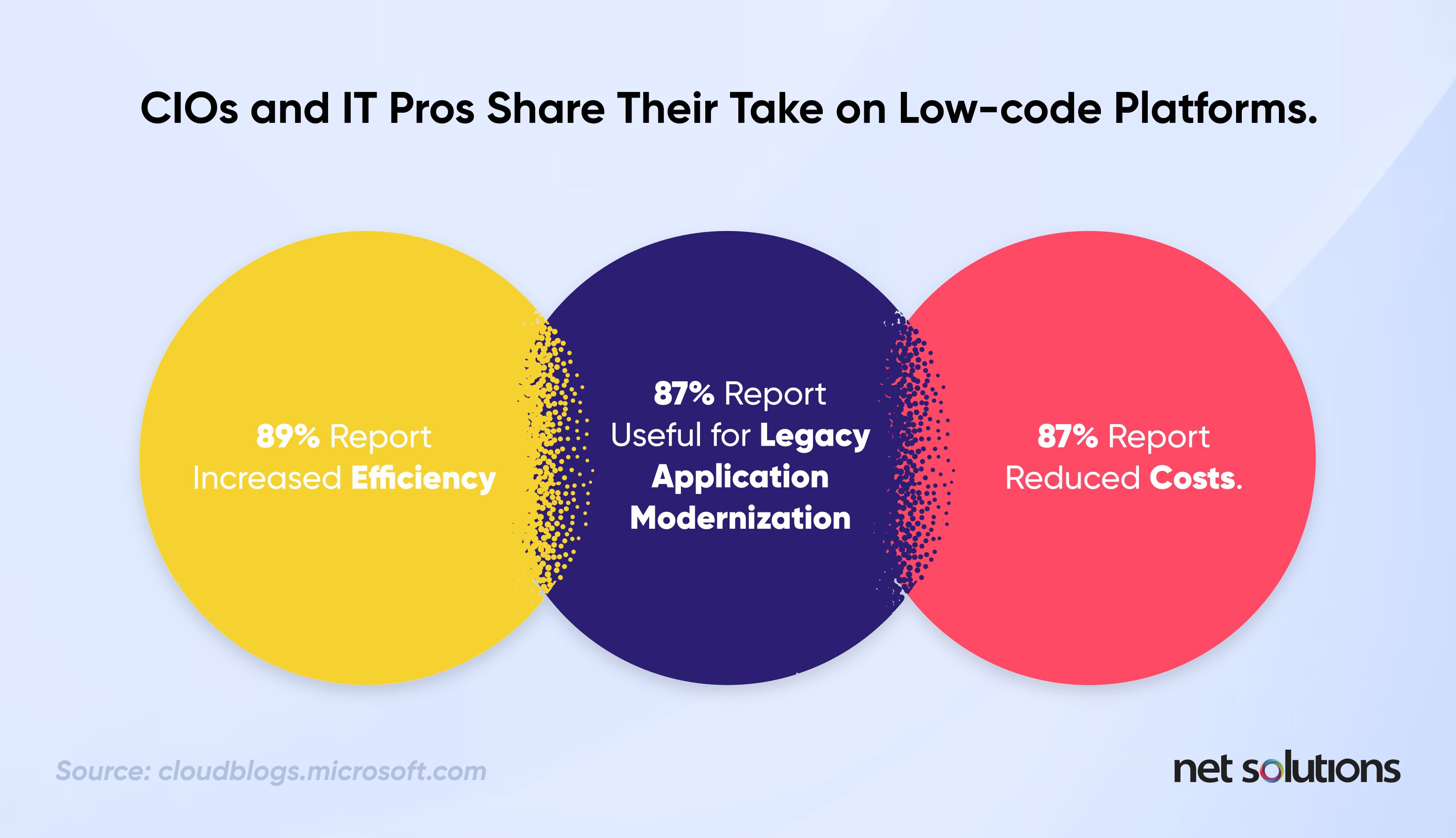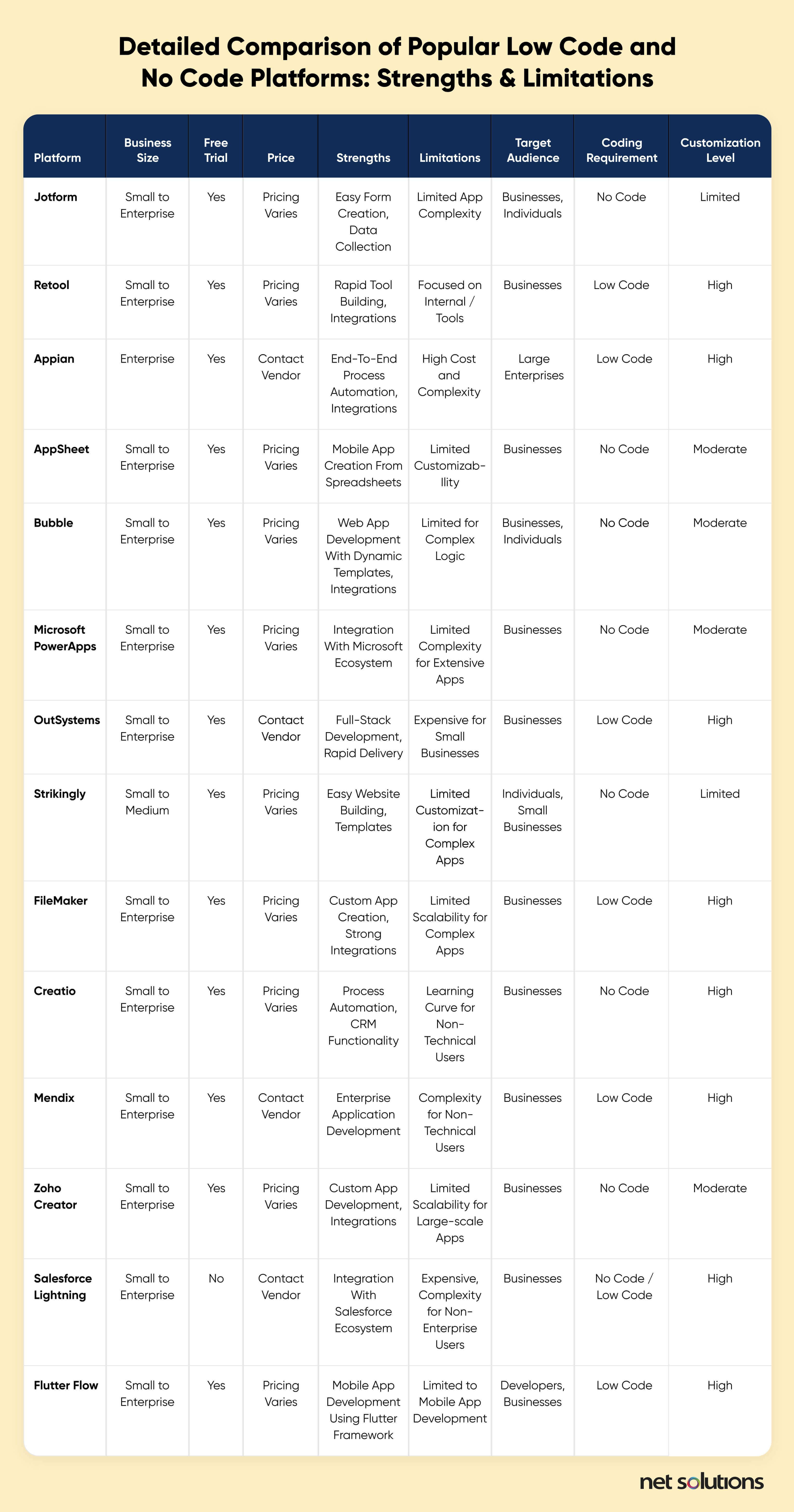Increased competition and shifting consumer demands have intensified the pressure on organizations to transform and rapidly innovate digitally. Low-code, no-code platforms enable organizations to innovate at scale, offering the ability to create applications more efficiently with fewer developer resources. This is particularly attractive with a shortage of skilled IT specialists. IDC projects that 750 million cloud-native applications will be created globally before 2025 – low-code, no-code tools will be key to delivering on these targets.
According to Gartner, the worldwide low-code development market is anticipated to grow 20% within 2023 and another 19% in 2024 – growth fueled by consistent returns in terms of cost savings, time savings, and accelerated innovation. Total economic impact studies suggest developer efficiency increases over time, demonstrating both short and long-term benefits from leveraging low code no-code platforms.

“Equipping both professional IT developers and non-IT personas — business technologists — with diverse low-code tools enables organizations to reach the level of digital competency and speed of delivery required for the modern agile environment.”
– Varsha Mehta, Senior Market Research Specialist at Gartner
What are Low-Code No-Code Platforms?
What are low-code no-code platforms? A Low-code no-code development platform (also displayed as low-code/no-code or low code no code) is a cloud-based development solution that makes it easy to create applications using drag-and-drop interfaces, business logic, workflow, and data services and simplified testing, deployment, and management tools.
Examples of low code no code platforms include Microsoft (MS) Power Apps, Bubble, Outsystems, and FlutterFlow. How many low-code no-code platforms are there? It is estimated that there are over 442 platforms currently available, of which 227 are low-code, and 176 are no-code platforms.
Low-Code vs No-Code Platforms
Although referred to collectively as low-code no-code, these terms apply independently:
No-code platforms leverage drag-and-drop interfaces to help create fully functional software – without any need to write code. No-code platforms are ideal for simple, practical applications that do not require custom elements or to create prototypes to help guide further development.
Low-code platforms combine drag-and-drop with the option to code some elements to add the flexibility and customizability needed to meet most product development needs. Low-code platforms can be leveraged to increase the efficiency of development teams, a “workflow assist” model that helps automate more mundane aspects of development and leverage quality code and built-in security elements, as well as testing and deployment tools, allowing time to focus more on custom elements.
Low-Code and No-Code Platforms Features & Capabilities
When assessing low code no code platforms, the following features and capabilities are standard:
- Visual interface and drag-and-drop functionality to create and customize applications
- Rapid application development with pre-built templates and reusable components
- Workflow automation for efficient task management
- Form builders for easy creation of custom forms
- Deployment and hosting options
While the above are very common across platforms, there are differentiating features that can set some platforms apart. The features of low code no code platforms that you’ll want to compare and contrast are:
- Integration with third-party services and APIs
- Data modeling and integration with various sources and APIs
- Mobile application development for iOS and Android
- Multi-platform / channel capability
- Collaboration and version control for team collaboration
- Scalability and performance optimizations
- Security features and access controls
- Analytics and reporting capabilities
Want to know how various tools stack up on these capabilities? Keep reading!
“Low-code development technologies are supporting the composable enterprise by enabling the creation of more agile and resilient software solutions,” said Wong. “These technologies can be used to compose and recompose modular components and PBCs, to create adaptive custom applications for changing business needs.”
– Jason Wong, Distinguished VP Analyst, Gartner
Why are Low-Code and No-Code Platforms Becoming Popular?
Low-code and no-code platforms are gaining popularity for many reasons, including:
Faster time to market / releases
These platforms leverage existing components and easy-to-use tools to reduce the need to build an application entirely from scratch and improve time for each subsequent release, useful for legacy application modernization projects and new product ideas.
Resource constraints
With a shortage of skilled IT development and increased demand for new applications, low code, and no code platforms can reduce time spent on mundane development and/or support the development of applications by non-skilled entrepreneurs. Further, where there is a large backlog of development requests, simple projects can be offloaded quickly via no-code low-code platforms.
Cost savings
The cost of hiring for and developing a custom application can be reduced significantly. These platforms are good for organizations of all sizes but are particularly attractive for organizations with limited resources (development and/or budget).
Greater security
Some platforms handle security and governance tools, though this can only partially eliminate the need to set up appropriate security measures (e.g., authentication) to protect sensitive systems and data.
Innovation
The ease of use of low code no code platforms allows business users / any user to translate ideas, encouraging innovation by users across the organization.
Rapid iteration and proof of concept
Developers can test ideas quickly by creating a proof of concept/prototype to help refine ideas for later development, an approach that helps reduce risk in product development.
Top Low-Code/No-Code Platforms and Their Suitability
Deciding to use a low-code or no-code platform isn’t just about saving time and money — it’s about making the best choice based on your business requirements and objectives today and in the future.
This section will examine the best low code no code platforms and what kinds of applications each are best suited for.
Jotform
A no code platform with large libraries and templates designed to help make tables, forms, and databases.
Choose For: Custom forms and databases
Retool
A low-code platform designed to support internal enterprise tools such as admin dashboards, database interfaces, custom reports, and more. Integrates with a variety of APIs and databases.
Choose For: Internal tools and applications
Appian
A low-code tool designed to help unify data across systems and support process automation.
Choose For: Process automation, process mining and optimization, data-based applications.
Google AppSheet
Google’s AppSheet is a no-code platform designed for individuals to build apps and connect to various data sources from the Google ecosystem and beyond.
Choose For: Web applications
Bubble
A top no-code app platform that offers dynamic, engaging templates and scalable infrastructure. High level of intuitive, visual development elements. Powered by Amazon Web Services with strong security & SEO.
Choose For: Websites and web applications (including eCommerce)
Microsoft Power Apps
A Gartner-recognized leader in enterprise low-code platforms. Connects with other Microsoft products directly within the portal with tailored AI models for automation (team, process, UI flows, and insights), extensive integrations, quick deployment, and extensibility.
Choose For: Websites, web apps, mobile apps. Includes no-code chatbots.
Outsystems
A Gartner-recognized leader in enterprise low-code platforms. A focus on high performance and user experience Offers the ability to deploy to cloud or on-premise, real-time dashboards, and a focus on developer tools to support deployment and scalability.
Choose For: Legacy application modernization, web applications, mobile apps
Strikingly
A user-friendly website builder that leverages extensive templates and elements, built-in analytics, and optimization tools. Includes options to create newsletters, sign-up forms, and live chat.
Choose For: Websites
FileMaker
A low-code platform with an intuitive UI and template library to build web and mobile apps. Includes an extensive partner network and is leveraged by well-known brands.
Choose For: Web and mobile apps
Creatio
A no-code platform to create apps and automate workflows with a strong focus on business, banking and manufacturing.
Choose For: Web apps, process automation and CRM
Mendix
A Gartner leading low-code platform for enterprise app development, cross-platform mobile development, legacy application modernization and process automation. A focus on securely integrating data and logic from external sources and legacy systems. Includes strong developer tools for version control, testing and deployment.
Choose For: Web and mobile apps, legacy application modernization, process automation
Zoho Creator
A low-code platform designed to help design and run business cross-platform apps. Supports over 550 integrations, process automations, and offers real-time, conversational analytics and AI capabilities.
Choose For: Cross-platform mobile apps
Salesforce Lightning
A recognized leader in the CRM space, a no-code / low-code option to build custom applications based on CRM data and a Process Builder to build complex workflows.
Choose For: CRM-based mobile apps, process automation
Flutter Flow
Ideal for creating cross-platform mobile apps, supporting custom interactive UI and a vast library
Choose For: Mobile apps (iOS / Android), web apps

Challenges of Low-Code No-Code Platforms and How to Solve for Them
While there are many benefits of low-code no-code platforms that are driving adoption, these tools are not without their challenges. However, some steps can be taken to help minimize the impact of or negate these challenges.
Limited Customization
Challenge: No-code platforms are the most restrictive of customization, focusing only on pre-build elements.
Solution: When choosing a low-code platform that is more flexible to customization, evaluate for the ability to custom script or support API integrations.
Security Concerns
Challenge: Low-code platforms could lead to oversights in security if code is not vetted or new vulnerabilities or best practices emerge.
Solution: Stay ahead of security by regularly auditing, checking for vulnerabilities, and addressing additional precautions (e.g., strong identity and access controls). More regulated industries should look to platforms supported by large teams with documented security best practices, including documentation on certifications such as ISO, SOC2, FedRAMP, or HITRUST, as needed. Establish service level agreements as necessary.
Rigid Templates and Components
Challenge: When designing an application, developers may hit a wall where the existing templates or components are unsuitable and cannot be customized enough (particularly for no-code platforms).
Solution: Have a more thorough idea of what you want to build so that you can vet templates and components before choosing and working with a tool. Choose a tool that allows for the customization required for the application design, ensuring the tool follows open standards and can run on any hardware or OS.
Critical: While these tools make it easier and faster to develop products, developing the right product and developing the product right requires that organizations continue to leverage the entire new product development process.
Limited Integration Options
Challenge: Integrating low-code and no-code platforms with existing enterprise systems and databases or with other systems could be complex, particularly with legacy systems.
Solution: Choose a platform that offers extensive API support and listed integrations to desired platforms, applications, or services, as well as the option to support with coding, as integrations may involve complex transformations or mappings that are not well supported by a visual interface.
Governance
Challenge: Ongoing maintenance of low-code and no-code platforms can be a challenge for users who are not familiar with or when platforms do not align with internal policies and practices.
Solution: Ensure you choose a platform that offers the capabilities necessary to meet compliance requirements, includes regular and automated updates, and offers a wide range of maintenance features.
Debugging and Troubleshooting
Challenge: Some low-code and no-code platforms lack extensive testing or debugging capabilities, particularly for unit testing.
Solution: Ensure the platform can support testing and debugging with log details to troubleshoot as necessary.
Limited Extensibility
Challenge: Some low code and no code platforms lack development control at one or more levels, including the front-end, back-end, database, and integration, either limiting how developers can work with the code or how data is consumed or exposed, creating data silos and limiting how systems can work together.
Solution: Ensure you choose a platform that provides the level of extensibility you require to ensure the greatest control and flexibility. For organizations with legacy systems or needing the greatest flexibility, ensure you can leverage pre-built extensions and integrations and build your own.
Platform Lock-In
Challenge: As with any software choice, there is a risk of platform lock-in when an application is developed using pre-built components or templates proprietary to a platform. Some platforms prohibit code from being moved or reused outside the platform.
Solution: Leverage trusted vendors and read terms carefully to avoid lock-in.
Scalability Constraints
Challenge: The ability to scale the application to support large numbers of users or to spin up new databases is a concern for any organization. This is a top concern of low-code app development, but some of the concern is not justified (although this is not universal.).
Solution: Thoroughly read the documentation in the chosen platform to understand the limits of the code and where alterations can be made to support long-term scalability if needed.
Complexity of advanced functionality
Challenge: While low code and no code platforms are easy solutions for simple applications or features, as applications increase in their requirements, this can increase the complexity of using these systems, with less straightforward ways to add code, add integrations, and data-related issues related to imports or significant volume processing.
Solution: Know when low code no code is correct for your project or architect your project such that low code no code platforms are leveraged for autonomous components of a larger microservices based application.
Software development constraints
Challenge: Some platforms do not adhere to software development practices that may be in play at an organization (e.g., version control, collaboration), leading to quality control issues when changes are not tracked, when changes are overwritten or if updates cannot be rolled back.
Solution: Ensure the tool of choice supports software development practices and has documented processes to avoid or settle merge conflicts.
Learning curve for platform-specific skills
Challenge: Some non-developer users or even some developer users may face a learning curve in understanding how to use these tools and what capabilities are at hand, a challenge that can add unforeseen time and expense to application development.
Solution: Organizations looking to accelerate application development with low-code and no-code tools have the option of offering comprehensive training (either with an internal staffer or third party) or hiring a skilled outsourcing partner to initial development and make the most of these valuable tools in the fastest, most optimized way. The ideal partner can also train internal staff to support ongoing governance.
How Net Solutions Can Accelerate Your App Development
While low-code and no-code solutions make it “easier” to develop apps, this does not mean it’s the right option for every application, or anyone can do it.
With expert product development experience and agility when working in low-code and no-code platforms, Net Solutions offers budget-friendly low-code and no-code application development services, fully optimizing the design and build of your apps in the short term and over time as your business needs to evolve and expand. The result? An efficient, built and optimized, high-performing app.
Low-Code No-Code FAQ
1.What is the difference between low-code and no-code platforms?
Low-code and no-code platforms help users, including those without extensive programming skills, create software applications. However, they differ in the degree of technical involvement and the complexity of the applications that can be developed using each platform.
No-code platforms offer an easy-to-use visual environment (drag-and-drop) of pre-built components and templates to help make applications. Low-code platforms allow for some coding, in addition to the above tools, to simplify software development.
2.Are low-code and no-code the future of app development?
As the demand for new applications and innovation continues to rise, there is no question that no-code and low-code tools will support app development in whole or in part with coding, mainly if resource constraints (time, money, IT skills) are a factor.
Furthermore, as these tools evolve in their sophistication, they can potentially democratize application development to a whole new set of users and ideas, leading to greater heights of innovation. The long-term viability of these approaches depends on their ability to evolve to new technologies and trends, adding new features, functionalities, AI-capabilities, and analytics, and evolving their code bases to new best practices.
3.Are there free low code no-code app builders?
There are free tools for no-code and low-code development of applications, but sometimes ‘free’ comes with limited capabilities, only basic features, or is on a platform that may not support your app in the long term. On the other hand, some free plans are a part of larger ecosystems of well-known brands, so do your research carefully.

